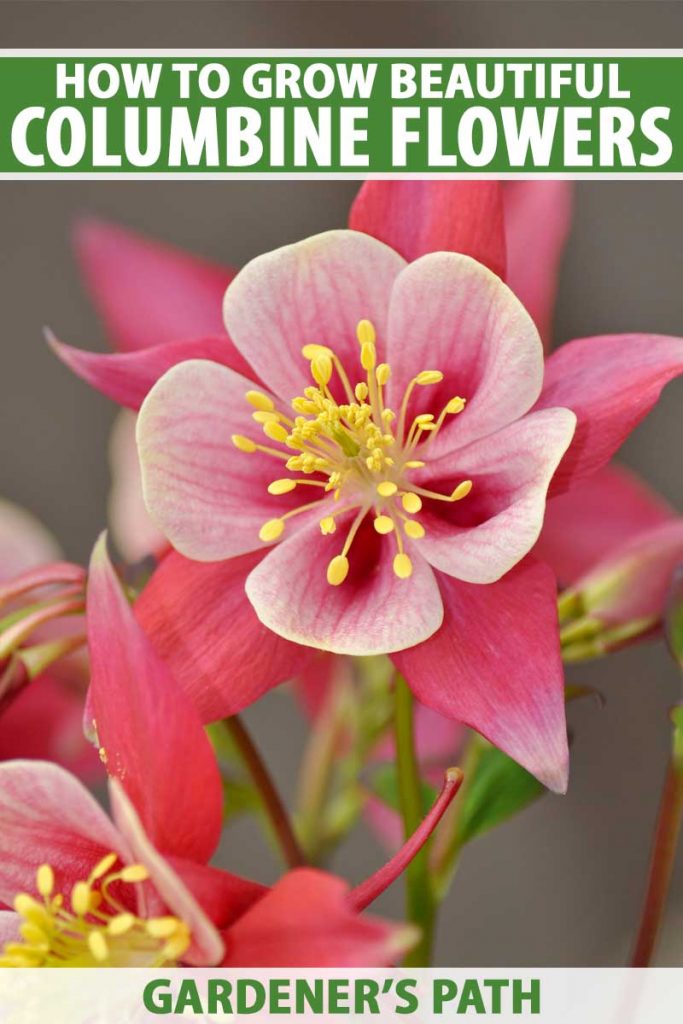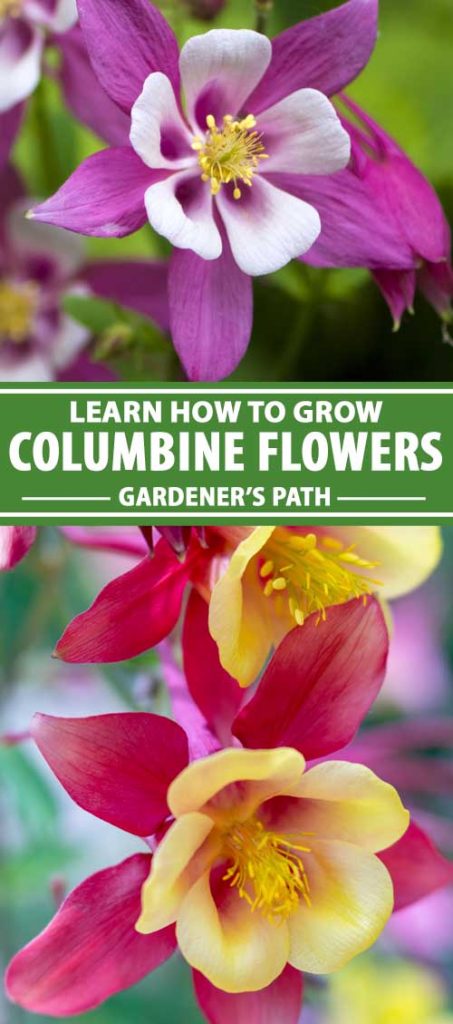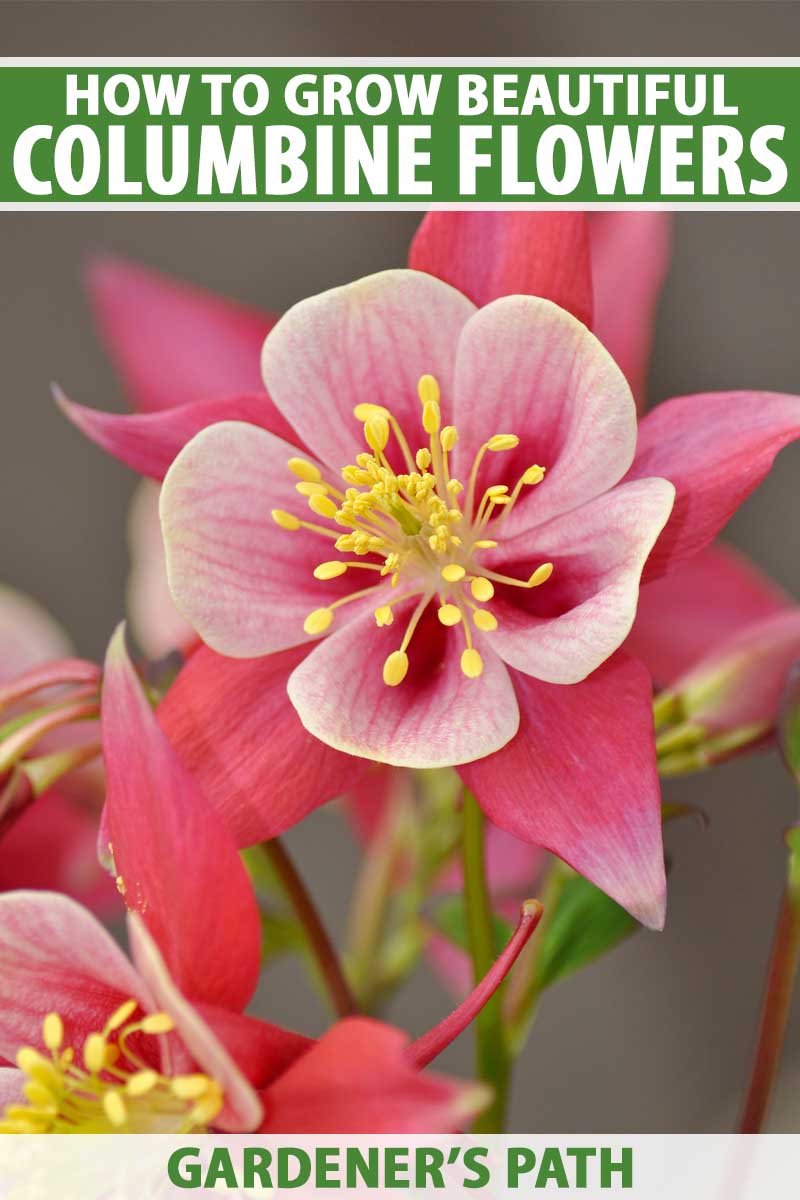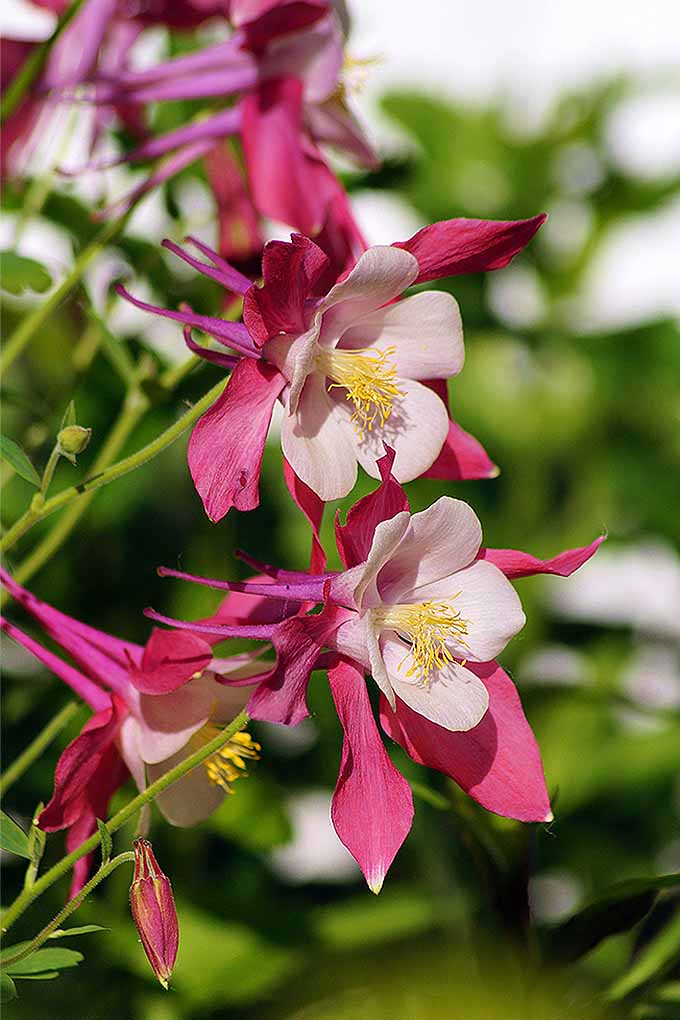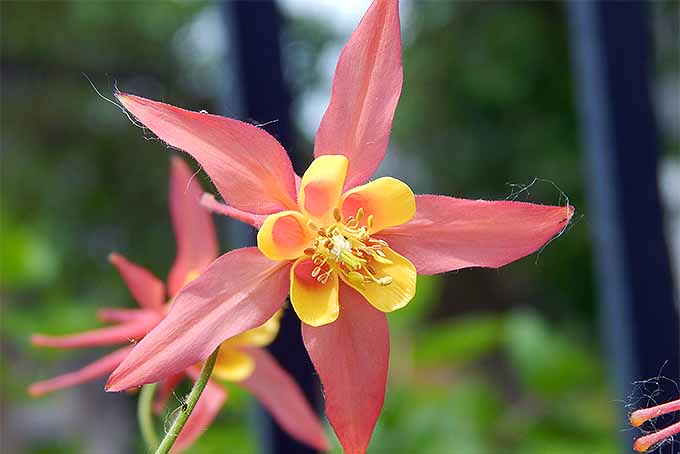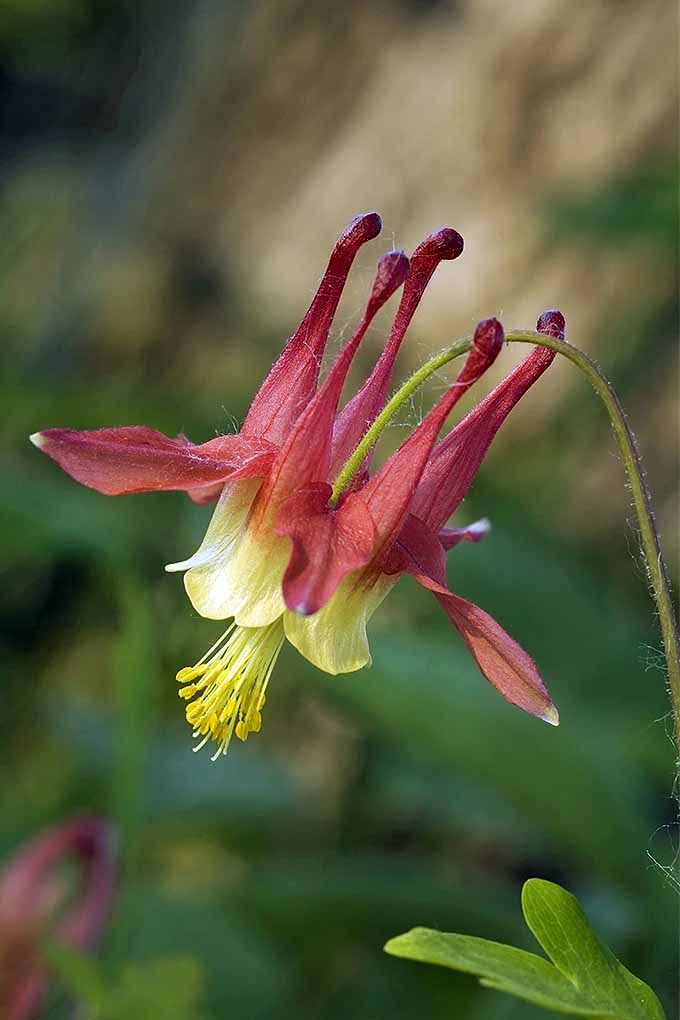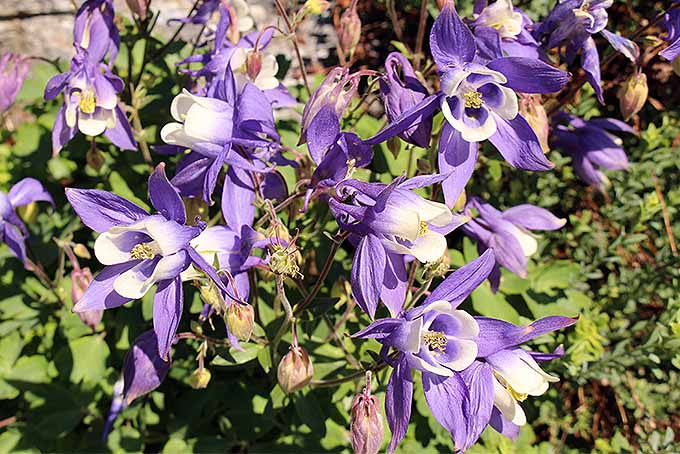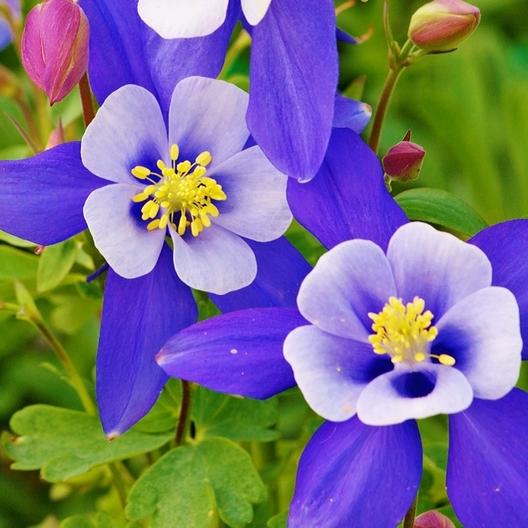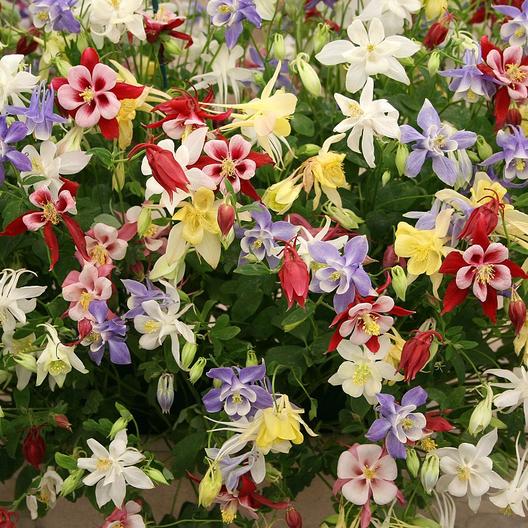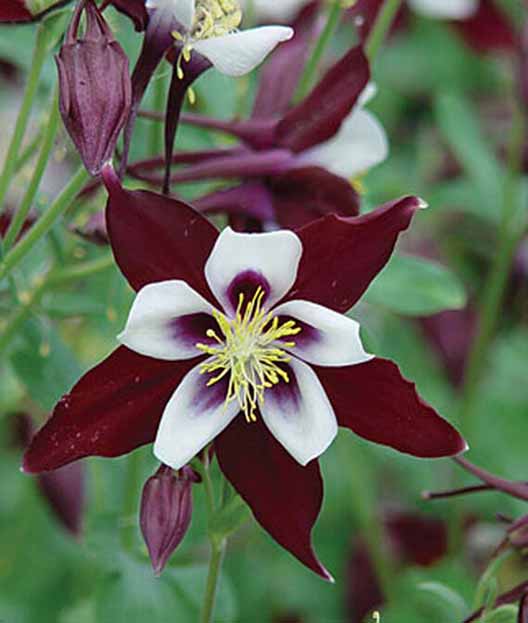It is an herbaceous perennial that blooms from spring to summer in USDA Hardiness Zones 3 to 9. We link to vendors to help you find relevant products. If you buy from one of our links, we may earn a commission.
What Are Columbine Flowers?
Sometimes called Granny’s bonnet or crowfoot, Aquilegia is native to the northeast regions of the United States and Canada. In addition to these native species, there are introduced species from Europe that are also available to the home gardener, as well as sought-after hybrids that have been cultivated to offer enhancements such as a varied color palette, exceptional hardiness, and impressive heights. Flowers offer a host of colors, including orange, pink, purple, red, white, yellow, and even green, with contrasting or matching centers. Sizes range from a petite six inches to almost three feet tall. Often two-toned, the flowers perch atop delicate stems that rise from a cushion of fern-like foliage. Slender nectar-filled spurs attract bumblebees and hummingbirds. In cool regions, Aquilegia grows well in full sun, however in warmer areas, it benefits from partial to full shade. Average to moist well-drained soil is best for this drought tolerant plant. A. canadensis, also known as Eastern or wild red columbine, is a native plant commonly found in the cool shade of woodland regions. Its characteristic downward-facing pendant blossoms of red or pink with yellow centers are well known to mountain hikers. Another native you might know is A. caerulea. The Colorado blue variety is described in our article on 11 Native Blue Wildflowers for the Garden. European Aquilegia has also made its way to the United States and is naturalized here. Common varieties include A. vulgaris and A. alpina.
Propagation
Columbine grows readily from seed. You can try dividing plants to make new ones, but the rootstock and foliage are very fragile and may not survive the process. This is a short-lived perennial, and plants usually last for about three years. However, it is also self-sower, so if you allow the seedlings to take hold, you may have blossoms for years to come. Keep in mind that while a native plant sows seeds identical to the parent plant, the seeds of a hybrid may or may not produce plants of equal quality, and the colors are likely to vary. In addition, plants growing in close proximity to one another are likely to cross-pollinate, further altering the hues of offspring grown from seed, and possibly resulting in the dominance of one color over others.
How to Grow
Start seeds indoors in late winter, or wait until the last average frost date of spring has passed in your area and sow them directly into the garden. Alternatively, you can sow seeds after the summer heat wanes, to allow plants to become established before the first frost. Lightly moisten the potting medium if starting indoors. Outdoors, work the soil down about six inches until it’s crumbly. Add sand or leaf mulch to improve drainage and loosen the soil as needed. Sprinkle the seeds on the soil surface and gently press them into place. Do not cover them. If you’ve started seeds indoors, set them in a cool place until the seed leaves, or cotyledons, appear. Then you may move them into indirect sunlight. Be careful of placement on a windowsill, as the glass concentrates heat and may scorch tender sprouts. Maintain even moisture, but do not over saturate. When the first true leaves appear, gradually acclimate seedlings started indoors to garden conditions by setting them outside for an hour or so the first day, two the next, and so on, for three or four days total, before transplanting them to the garden. When planting or transplanting outdoors, choose a location with full sun to part shade that has average soil and drains very well. If you want to know its pH and assess its quality, conduct a soil test. Once in the garden, continue to provide the seedlings with even moisture, but do not over saturate the soil. As the weather warms up, be sure to water weekly in the absence of rain.
Growing Tips
Chill seeds overnight to jump-start germination before sowing. Provide adequate drainage, as standing water in winter is likely to rot the perennial rootstock during dormancy. If you have a favorite variety, don’t plant it near other cultivars, as cross-pollination is likely. Space plants per seed packet instructions, to inhibit a buildup of humidity that may lead to fungal disease.
Best Uses
Aquilegia is a useful plant for beds and borders because it comes in a wide variety of colors, has a shallow root system, and grows in clumps. A popular choice for cottage-style gardening, it performs well among both tall and short plants, as its foliage is sparse. Aquilegia benefits from the shade cast by shrubbery or taller companions, and creates a delicate, wispy foreground display. It’s also great in containers and for gardening in small spaces, where well-behaved plants are essential. Good companions to plant with columbine are allium, daylily, foxglove, heuchera, iris, peony, phlox, and poppy. Introducing Aquilegia to the landscape is an excellent way to attract beneficial pollinators, such as bumblebees, butterflies, and hummingbirds.
Maintenance
As described, consistent moisture is necessary during germination and the seedling stages. Once plants are well established in the garden, weekly watering in the absence of rain is recommended. Plants are short lived, but will self-sow. Remember that hybrids produce seedlings that differ from parent plants, so if you don’t want a “potluck” variety of plants growing next to your prize specimens, be sure to weed them out. Pot up the volunteer seedlings to give to friends, transplant them away from the parent plant, or dispose of them on the compost heap. Weed the garden regularly to minimize competition for water. This is also a good way to discourage insect infestation. Deadhead spent blossoms throughout the growing season, to encourage more to grow.
Managing Pests and Disease
Aquilegia attracts leaf miners, little brown/black flies that lay their eggs on the undersides of the leaves. When the larvae hatch, they eat their way through the foliage, causing unsightly damage, but not killing the plants.
Blue Star
The upward-facing ‘Blue Star’ flowers consist of unusual cerulean blue, star-like outer sepals with slender spurs and contrasting white centers. They make a stunning focal point in the garden.
A. caerulea ‘Blue Star’ Plant these en masse near an entryway to create a festive spring-to-summer welcome for visitors to your home. Blossoms measure three to four inches in diameter, and you can expect plants to reach a height of about 30 inches. Bloom time is from spring into summer. Find ‘Blue Star’ seeds now from Eden Brothers.
McKana Giant
For a striking drift of multicolor blossoms, you can’t beat the vertical interest of two- to three-foot ‘McKana Giant.’
A. hybrida ‘McKana Giant’ Mix Upward-facing flowers appear to be hand-painted in shades of purple, red, white, yellow, and bi-color arrangements, with eye-catching long spurs. Each measures two to three inches across. Bloom time is from spring into summer. Find ‘McKana Giant’ Mix seeds now from Eden Brothers.
Swan Burgundy and White
Deep burgundy sepals and long spurs that appear to be made of velvet are features of this cultivar, and white centers accented with the same saturated burgundy hue provide rich contrast. Flowers measure 2 to 3 inches across.
‘Swan Burgundy and White’ With a moderate height of 18 to 20 inches, this variety is perfect for blending with companion plantings. Its color scheme plays well with both pastel and bold-toned flowers. Bloom time is from spring into summer. Find ‘Swan Burgundy and White’ seeds now from Burpee.
Wild Columbine
Wild columbine, A. canadensis, aka Eastern red columbine, is a native species that grows wild in Canada. Wildflowers have smaller flowers than hybrids, as well as shorter heights. In addition, their heads nod, facing downward rather than outward, and their spurs point up.
Wild Columbine, A. canadensis Eastern red columbine has 1- to 2-inch flowers. The sepals are red, with contrasting yellow centers. The spurs are red as well, and much shorter than those of hybrid types. Heights range from 1 to 2 feet. Planting en masse is the only way to attract attention to this sweetheart, as its nodding blossoms are so small, unless perhaps you are gardening in a small space with just a few featured specimens. This native species blooms in the spring. Find wild columbine plants now from Nature Hills Nursery. Be sure to check out our supplemental guide, “35 Columbine Varieties for the Spring Garden” to find the perfect cultivar(s) for your needs. If you see eggs, insects, or larvae, pick them off and discard them in the trash. If they are still a problem, apply neem oil. This is a natural pesticide that should take care of the problem. You may also encounter powdery mildew, a fungal disease that leaves a dusty white coating on leaf surfaces. In addition to being unattractive, it can stunt growth or kill plants. Again, neem oil is the answer, as it is also a fungicide. Some folks apply it preventatively, before trouble starts.
Quick Reference Growing Guide
Welcome Spring
I’ve always enjoyed growing these lovely harbingers of spring. When they begin to grow beneath my weeping cherry, I know another Northeastern winter is behind me, and the days will soon be warm. Now it’s your turn to experience the joy of seeing this beauty when it makes its spring debut. Let’s recap:
Aquilegia is available in native, introduced, and cultivated varieties. The flowers have eye-catching colors and unusual spurs, giving them an exotic, ephemeral appearance. You may sow seeds before summer heats up, or after it cools down. A variety of flowers play well with it and it can be used to created attractive mixed plantings. Beneficial pollinators seek its nectar. Routine maintenance is of moderate difficulty, centering mostly on even moisture and adequate drainage. Pests and diseases are few.
Will you welcome spring with the dainty elegance of columbine this year? And for more spring flower ideas, check out some of our other growing guides:
Grow Cardinal Climber for Spring to Frost Color How to Grow Heavenly Hyacinths for Rich Spring Color and Sweet Perfume Delightful Daffodils, A Springtime Must-Have
Product photo via Eden Brothers, Burpee, and Nature Hills. Uncredited photos: Shutterstock. First published on February 3rd, 2017. Last updated March 4th, 2020. With additional writing and editing by Allison Sidhu and Clare Groom.
